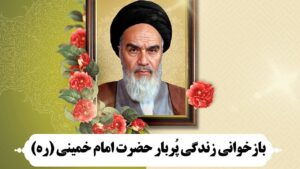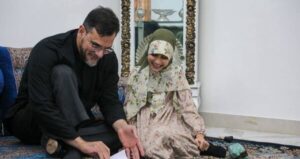
In December 2024, an event occurred in the political geography of the Middle East that fundamentally changed the political and geographical reality of the region. The “Tahrir al-Sham” group, which operated for years in a region of Syria supported by Turkey, was able to overthrow Bashar al-Assad’s government within a short period of time and attract the attention of the world.
On this occasion, Seyyed Reza Sajjadinejad, the editor of Din Online, discussed this issue in a conversation with Dr. Mohammad Masjid Jamei at Maram Institute on January 8, 1403.
Mr. Doctor, this matter has different dimensions and profound effects. Please give an introduction about this event and the reasons for its occurrence.
This issue is very complex and multidimensional. If we want to investigate it, we must address the reasons for its occurrence, the quality of its occurrence, and its consequences for Syria and neighboring countries and the region, and even international relations. This incident is very different from what we see in Sudan for example. Despite the ongoing violence in Sudan, its impact on neighboring countries or the international arena is not as great as the impact of the Syrian crisis. The situation in Syria has been very unstable in recent years, especially since the middle of the last decade. This instability was evident in different dimensions, especially in the field of livelihood. Therefore, the occurrence of such an incident is not strange; Perhaps the more correct question is why this incident did not happen earlier.
Can you explain the religious and ethnic fragmentation in Syria?
Syria is part of the ancient Levant, a region that was under the rule of the Eastern Roman Empire before the Islamic conquests, and before that, the Roman Empire. This area has been civilized for a long time and different tribes and groups have lived in it. In a short period, it was under the rule of Achaemenids and Sassanids. After the arrival of the Arabs, the first Islamic empire was formed in Syria, as the Orientalists and sometimes some Arabs say. The policies of the Umayyads were very different from those of the Abbasids, whose caliphate was centered in Baghdad. The Levant region, including Syria, Jordan, Lebanon and Palestine (of which Israel is also a part), has and has differences from other regions in terms of religion and religion, due to its turbulent history and the policies of the Umayyads, especially Muawiya.
Can this historical integration be followed until today?
No, there is no historical integrity in this area. Unlike Iran, which has always been under the rule of Iranian ethnic groups, in Levant, the rulers have often been from non-local ethnic groups. After the independence of Syria in the contemporary period, the Syrians took power. Although, only once was the emperor of Rome at the end of the 3rd century AD a Syrian named “Philip the Arab”.
How is the religious and ethnic fragmentation of Syria today related to this historical background?
Syria’s minorities can be divided into two groups: groups with a pre-Islamic background, such as Christians, who are very diverse, and groups that formed after Islam, such as Sunnis, Alawites, Druzes, and Twelver Shiites. Syrian Christians belong to different churches, and this religious diversity has increased in different historical periods, including under the influence of Christian missionaries from the 18th and 19th centuries onwards.
What do you think about the role of different ethnic groups, especially the Kurds?
Syria is not the only host for the Kurds; This country, like other regions of the Middle East, is home to many ethnic groups. Kurds are one of the major ethnic groups in Syria. For example, the number of Armenians in this country is significant.
How do you evaluate the role of the Baath Party and the Alevi minority government over the Sunni majority?
The Baath Party was formed in a special historical context. The party, founded by Michel Aflaq and Salah al-Din Bitar (both Christians), promoted an ideology based on Arab ethnicity, Arab unity, and a form of socialism. This ideology gained a lot of attention in the 1950s and 1960s and eventually came to power and was considered one of the most progressive parties in that historical period. Even the founder of the “Muslim Brotherhood” in Syria is a scholar named Mustafa al-Saba’i, who wrote the book “Al-Ashtrakiya al-Islam”.
Why is the situation in Syria today different from the past?
The world has changed and the conditions of the Middle East region have also changed more strongly. Political and social changes occur in this region much faster than in other parts of the world. This change is internal and social and is deeply influenced by virtual space. In order to maintain their position, the governments of this region are trying to align themselves with the developments from within. A good example is the Saudi Arabia of Salman and Bin Salman. There are many reasons for the intensity and speed of social and cultural changes in this region. One of the most important is the great influence of traditional culture. This penetration intensifies and strengthens the rapid absorption of what is in the virtual space. All this leads to some kind of political instability.
What is the influence of the religious beliefs of the Sham region, especially the interest in Muawiya and the Umayyads, in the current developments?
The Levant region was influenced by the policies of Muawiya and the Umayyads from the beginning, and this influence continues. Mu’awiyah and the Umayyad dynasty have special respect in this region and this interest has been highlighted and strengthened again in the contemporary period with the emergence of Arab nationalism. This nationalism mainly relies on the history of the Umayyads. This point in history was so important to his fans that the former president of Iraq, Abdul Salam Aref, who had a strong nationalist tendency, was also proud of it. However, Iraqis and Syrians were constantly competing.
Were Umayyad policies in the Levant different from other regions?
Yes, Umayyad policies in the Levant were much milder than in other regions. This behavior caused a positive memory of the Umayyads to remain in the Levant, unlike the Islamic East, from Iran to the Arabian Peninsula, Yemen and North Africa, where the Umayyad policies in these areas were discriminatory and extremely oppressive. Examples are Ziyad, Ibn Ziyad and Hajjaj.
Following the fall of Bashar al-Assad’s government and drawing international attention to the “Tahrir al-Sham” group, the issue of Türkiye became one of the topics discussed among Iranian journalists. Some interpreted these developments along the lines of the policies of the Ottoman Empire and cited quotes that indicated Türkiye’s expansionism in the form of these developments. According to the explanations you provided, it seems that this issue has different dimensions. My question is, to what extent is the current situation in Syria, from the contemporary era, that is, the time of the Baath party, to today, with its special religious fragmentation, rooted in historical issues?
Syria is a country with deep and influential historical layers. Unlike countries like Sudan, Rwanda, Burundi, or even Bolivia and Nicaragua that may have experienced unrest, the unrest in Syria is different. One of the important issues in Syria, which is less understood in Iran and is a special feature of some Arab countries, is the issue of “sectarianism”.
Being sectarian means combining a particular religion or religion with a specific ethnicity. This combination is effective both in the behavior of the sect and in the society’s perception of them. In Syria, this issue is very strong, as we witnessed in Iraq. Even in Bahrain, there was such a situation.
In Syria, the majority of the population are Sunnis, mostly Shafi’i or Hanafi. Alawites are one of the big minorities. It is not possible to understand the situation of Alevis and other minorities without considering the four centuries of Ottoman rule and their policies in this region. The policy of the Ottomans was to marginalize non-Khodi groups, especially the Alawites. This policy drove the Alevis to the mountainous and inaccessible areas, where they could maintain their security. They formed their own “closed society” and the evolutionary mechanisms in a closed society are completely different from a non-closed society, especially in terms of thought, belief and behavior, which is a detailed discussion.
It seems that the policies of the Ottomans towards the Alevis and other groups had profound effects. Did these policies help to form the society’s negative attitude towards the Alevis?
Yes, exactly. Ottoman policies, often accompanied by the support of the Sunni masses, shaped public attitudes against the Alawites. In the Ottoman Empire, due to the legitimacy of the caliph, the caliph’s words were accepted. This made the Sunni masses in the Levant region, especially in Syria, naturally suspicious of the Alawites.
In the new era, with the emergence of Arab nationalism and the ideology of the Baath party, slogans were raised and they tried to remove religion from the social scene and introduced everyone as an equal citizen. These slogans were effective to some extent, but in the 1980s, a severe conflict arose between the Alawites and the Sunnis, especially the Muslim Brotherhood of Syria. This conflict was accompanied by violent actions on both sides.
It seems that these conflicts have been strong and weak in different periods. Have Alevis always been in conflict with other groups?
No, it has not been like this. In the 40s, 50s and 60s, there were not many conflicts. Conflict occurs when there are incentives to provoke the parties. In the Ottoman era, this conflict existed, but in the modern era, due to nationalist thoughts, it became less. In the 1980s, these conflicts rose again for some reason, and the neighboring countries, especially Jordan and Iraq, also played a role in this. They provided a large number of weapons to those who were armed. The insurgents were young people with Islamic and Brotherhood tendencies. These measures made the situation deeply and quickly secure. Finally, it led to an uprising in the city of Hama, which was severely suppressed and a large number of people were killed. After this incident, the gap between the people and the government was never healed.
What is the difference between the Alevis of Syria and the Alevis of Türkiye? It seems that the general knowledge about Alevis, especially in Iran, is not accurate.
The main difference between Syrian and Turkish Alevis is their ethnicity. Syrian Alevis are Arabs, while Turkish Alevis are Turks. In Iran, due to the prevailing religious mentality, all issues are seen from the perspective of religion. They think that only religion will bring about changes and they actually ignore other factors which are sometimes very important.
Some believe that the Muslim Brotherhood is part of Tahrir al-Sham, and the changes in the leadership of this group, such as the appearance of its leader, Ahmad al-Shara, are related to this issue. What do you think?
This notion is wrong. Ahmad Al-Shara today is different from Ahmad Al-Shara 2015 or 2011. Subversive and Takfiri Islamic movements have also experienced many changes in the last decade. These changes have occurred not only among these groups, but also in the public opinion and religion of the people of the region. As mentioned, virtual space has also had a significant impact on these changes.
The changes you mentioned, such as the necktie of Tahrir al-Sham’s leader, have led some to conclude that the group is no longer willing to resist Israel. Is this perception correct?
This issue has nothing to do with cravating. Syria today is in transition and its people are under severe pressure, especially in terms of livelihoods. The current priority of the Syrian people is not resistance or political issues, but livelihood issues and the security and integrity of the country.
In addition, Croatia should be seen in the context of the current situation. I personally know Mr. Ben Kiran, the secretary general of Maghreb “Justice and Development” party, and he was the prime minister of this country for some time after Saad al-Din Osmani. He is indeed a respectable person and has good Islamic information, and during the martyrdom of Nasrallah, he expressed his condolences that he was criticized inside his country. Before he became the prime minister, he usually wore a western dress and not a suit. But since then, it has changed and is still used in many cases. The text of the society has changed and he himself has also become more modern. This flow is a reality. Many Iraqi official and Islamic figures did so after the fall of Saddam, while they were not like this before.
What does the protest of Syrian Christians to the burning of the Christmas tree and their large presence in the streets indicate? Do identity issues also play a role in these protests?
The protest of Christians is due to the fear of repeating similar events in Iraq or the behavior of ISIS. They feel that if they do not protest now, their churches and holy places may be blown up in the future.
Are there similar concerns in Jordan?
No, the social structures and the power structure in Jordan are completely different from Syria. Jordan has a monarchy that interacts relatively closely with its people, and this has made it relatively stable. Especially the king, especially the king is one of the nobles. Jordan has always been a part of the conservative Arab world and has actually played a large role in stabilizing the position of conservative regimes, exactly the opposite of Syria. In addition, Syria was not accepted even by the progressive regimes due to mainly sectarian reasons. In recent decades, Syria suffered a kind of political isolation, even among Arabs.
In another session, we will discuss issues related to the interaction between Türkiye and Syria and the issue of the Kurds. Thank you very much.
I thank you too.
منبع: www.khabaronline.ir



